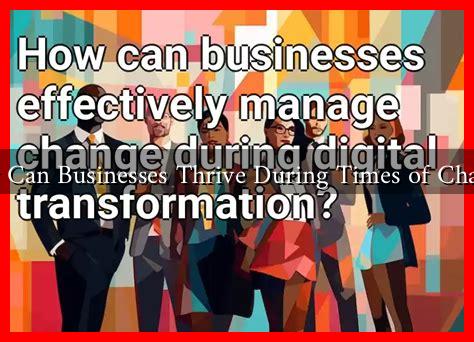-
Table of Contents
How Can Businesses Thrive During Times of Change?
In an ever-evolving global landscape, businesses face constant change driven by technological advancements, economic fluctuations, and shifting consumer preferences. While change can be daunting, it also presents unique opportunities for growth and innovation. This article explores strategies that businesses can adopt to not only survive but thrive during times of change.
Understanding the Nature of Change
Change is an inevitable part of the business environment. It can manifest in various forms, including:
- Technological advancements (e.g., AI, automation)
- Market dynamics (e.g., new competitors, changing consumer behavior)
- Regulatory changes (e.g., new laws, environmental regulations)
- Global events (e.g., pandemics, economic crises)
Recognizing the nature of change is the first step in developing a proactive approach. Businesses that understand the drivers of change can better anticipate challenges and seize opportunities.
Embracing Agility and Flexibility
Agility is the ability to respond quickly to changes in the market. Businesses that cultivate a culture of flexibility can adapt their strategies and operations to meet new demands. Here are some ways to enhance agility:
- Streamline decision-making: Empower teams to make decisions quickly without excessive bureaucracy.
- Invest in technology: Utilize tools that facilitate real-time data analysis and communication.
- Encourage a growth mindset: Foster an environment where employees are encouraged to learn from failures and adapt.
For instance, during the COVID-19 pandemic, many restaurants pivoted to delivery and takeout services, leveraging technology to maintain customer engagement. Companies like Domino’s saw a significant increase in sales by quickly adapting their business model to meet changing consumer needs.
Fostering Innovation
Innovation is crucial for businesses looking to thrive amid change. Companies that prioritize innovation can differentiate themselves from competitors and capture new market segments. Here are some strategies to foster innovation:
- Encourage collaboration: Create cross-functional teams to brainstorm and develop new ideas.
- Invest in research and development: Allocate resources to explore new products, services, or processes.
- Engage with customers: Solicit feedback and involve customers in the innovation process.
A notable example is Netflix, which transitioned from a DVD rental service to a streaming giant by continuously innovating its content delivery and production strategies. This adaptability has allowed Netflix to remain a leader in the entertainment industry.
Building Strong Relationships
During times of change, strong relationships with stakeholders—employees, customers, suppliers, and investors—are vital. Here’s how businesses can strengthen these relationships:
- Transparent communication: Keep stakeholders informed about changes and how they will be affected.
- Show empathy: Understand and address the concerns of employees and customers during transitions.
- Collaborate with suppliers: Work closely with suppliers to ensure a smooth supply chain during disruptions.
For example, during the pandemic, many companies increased their communication efforts with customers, providing updates on safety measures and service changes. This transparency helped build trust and loyalty.
Leveraging Data and Analytics
Data-driven decision-making is essential for navigating change effectively. Businesses that leverage analytics can gain insights into market trends, customer behavior, and operational efficiency. Here are some ways to utilize data:
- Monitor key performance indicators (KPIs): Track metrics that reflect business health and customer satisfaction.
- Analyze market trends: Use data to identify emerging trends and adjust strategies accordingly.
- Personalize customer experiences: Utilize customer data to tailor products and services to individual preferences.
According to a report by McKinsey, companies that effectively use data analytics are 23 times more likely to acquire customers, 6 times more likely to retain customers, and 19 times more likely to be profitable. This underscores the importance of data in driving business success.
Conclusion
In conclusion, while change is a constant in the business world, it does not have to spell disaster. By embracing agility, fostering innovation, building strong relationships, and leveraging data, businesses can not only navigate change but also thrive in it. The key takeaway is that adaptability and proactive strategies are essential for long-term success. As the business landscape continues to evolve, those who are prepared to embrace change will emerge as leaders in their industries.
For further insights on business adaptability, consider exploring resources from the Forbes Human Resources Council.

